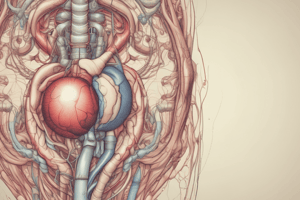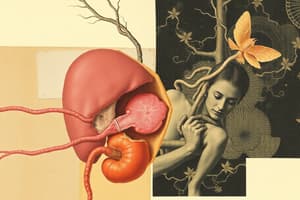Podcast
Questions and Answers
Why is it important for physical therapists to understand kidney function?
Why is it important for physical therapists to understand kidney function?
- To perform surgeries on the renal system.
- To assess all types of abdominal pain.
- To treat kidney-related diseases directly.
- To differentiate between musculoskeletal pain and referred pain from the kidneys. (correct)
What is one of the primary roles of the kidneys in the body?
What is one of the primary roles of the kidneys in the body?
- Producing hormones that stimulate appetite.
- Facilitating digestion of nutrients.
- Regulating fluid volume and electrolyte concentration. (correct)
- Storing energy in the form of glycogen.
What can be a complication for patients with limited kidney function?
What can be a complication for patients with limited kidney function?
- Excessive fluid retention. (correct)
- Enhanced digestive enzyme activity.
- Elevated red blood cell count.
- Increased levels of insulin production.
In which situation may a physical therapist encounter patients with limited kidney function?
In which situation may a physical therapist encounter patients with limited kidney function?
How do kidneys regulate blood pressure?
How do kidneys regulate blood pressure?
What is the functional unit of the kidney responsible for urine formation?
What is the functional unit of the kidney responsible for urine formation?
Which part of the kidney is primarily responsible for the intake and outflow of blood?
Which part of the kidney is primarily responsible for the intake and outflow of blood?
What structure allows for the transport of urine from the kidneys to the bladder?
What structure allows for the transport of urine from the kidneys to the bladder?
Which component of the urinary system is a muscular storage reservoir for urine?
Which component of the urinary system is a muscular storage reservoir for urine?
How does the autonomic nervous system control the bladder?
How does the autonomic nervous system control the bladder?
What is the primary function of the Bowman's capsule in the nephron?
What is the primary function of the Bowman's capsule in the nephron?
Which part of the male urethra runs through the prostate gland?
Which part of the male urethra runs through the prostate gland?
What anatomical structure connects the testes to the urethra?
What anatomical structure connects the testes to the urethra?
What role does the renal medulla play in kidney function?
What role does the renal medulla play in kidney function?
Where does urine travel after it is collected in the renal pelvis?
Where does urine travel after it is collected in the renal pelvis?
What condition may be misinterpreted as non-specific back pain due to kidney issues?
What condition may be misinterpreted as non-specific back pain due to kidney issues?
Which of the following is NOT a function of the kidneys?
Which of the following is NOT a function of the kidneys?
Why is understanding kidney function important in outpatient settings?
Why is understanding kidney function important in outpatient settings?
How do the kidneys help regulate blood pressure?
How do the kidneys help regulate blood pressure?
In terms of their anatomical location, the kidneys are described as what?
In terms of their anatomical location, the kidneys are described as what?
What is the primary role of the renal hilum in the kidney?
What is the primary role of the renal hilum in the kidney?
Which part of the kidney is involved in the final stages of urine concentration?
Which part of the kidney is involved in the final stages of urine concentration?
What characteristic of the bladder's muscle structure allows it to function effectively?
What characteristic of the bladder's muscle structure allows it to function effectively?
Which structure is responsible for reabsorbing fluids during urine formation?
Which structure is responsible for reabsorbing fluids during urine formation?
How does the autonomic nervous system influence bladder function?
How does the autonomic nervous system influence bladder function?
What anatomical structure helps protect the kidneys from physical damage?
What anatomical structure helps protect the kidneys from physical damage?
What is the function of the urethra in the urinary system?
What is the function of the urethra in the urinary system?
Which statement correctly describes the male urethra?
Which statement correctly describes the male urethra?
What component ensures that urine is collected from the kidneys before being passed to the ureters?
What component ensures that urine is collected from the kidneys before being passed to the ureters?
Which part of the nephron is primarily responsible for the initial filtration of blood?
Which part of the nephron is primarily responsible for the initial filtration of blood?
Flashcards are hidden until you start studying
Study Notes
Overview of Pelvic Viscera
- Awareness of pelvic viscera is important for physiotherapists (PTs) to recognize potential referred pain and red flags.
- Pelvic viscera includes structures like kidneys, which are vital for understanding functions and locations in relation to pain.
Kidney Functions and Location
- Kidneys are retroperitoneal, located deep against the back wall of the abdominal cavity.
- Kidney pain can refer to lumbar spine or general back pain, necessitating a thorough assessment in cases of non-specific back pain.
- Limited kidney function can affect patients on dialysis, leading to complications or secondary effects.
Functions of the Kidneys
- Regulate fluid volume through urine removal, maintaining appropriate osmolarity and acid-base balance.
- Regulation of electrolyte concentrations and blood pressure is critical.
- Secrete hormones that impact metabolism and excrete waste products and foreign substances.
Urine Formation
- Urine formation begins with blood entering the kidney and filtering into Bowman's capsule.
- Fluid reabsorption and secretion occur in various tubules, concentrating urine before it is excreted through ureters to the bladder and out via the urethra.
Kidney Structure
- The renal hilum is the central area for renal artery, vein, and pelvis.
- Outer cortex is where initial filtration occurs, while the inner medulla conducts final filtration.
- Nephrons are the functional units of the kidneys.
Urinary Tract Overview
- Kidneys and suprarenal glands are located against the posterior abdominal wall and surrounded by fat for protection.
- Ureters transport urine from kidneys to the bladder, which is a muscular reservoir for storage.
Bladder and Urethra
- The bladder is controlled by the autonomic nervous system for filling and expulsion of urine via the urethra.
- Male and female urethras have structural differences; male urethra serves both urinary and reproductive functions, passing through the prostate and penis.
Male Reproductive System
- The testes are external, connected to the body via the spermatic cord through the inguinal canal.
- Understanding the relationship between the urethra, vas deferens, and prostate is critical for pelvic health PTs, especially post-prostate cancer.
Female Reproductive System
- Key components include the ovaries, uterine tubes, uterus, cervix, and vagina—all muscular organs closely linked to the pelvic floor.
- The vagina and urethra are integral openings within the pelvic floor, relevant for pelvic health practices.
Pelvic Floor and Internal Work
- In pelvic health, understanding the pelvic floor’s role is crucial, including recruitment and soft tissue manipulation through vaginal access.
- More detailed knowledge of pelvic health systems will be obtained in specialized clinical courses or certifications.
Overview of Pelvic Viscera
- Awareness of pelvic viscera is important for physiotherapists (PTs) to recognize potential referred pain and red flags.
- Pelvic viscera includes structures like kidneys, which are vital for understanding functions and locations in relation to pain.
Kidney Functions and Location
- Kidneys are retroperitoneal, located deep against the back wall of the abdominal cavity.
- Kidney pain can refer to lumbar spine or general back pain, necessitating a thorough assessment in cases of non-specific back pain.
- Limited kidney function can affect patients on dialysis, leading to complications or secondary effects.
Functions of the Kidneys
- Regulate fluid volume through urine removal, maintaining appropriate osmolarity and acid-base balance.
- Regulation of electrolyte concentrations and blood pressure is critical.
- Secrete hormones that impact metabolism and excrete waste products and foreign substances.
Urine Formation
- Urine formation begins with blood entering the kidney and filtering into Bowman's capsule.
- Fluid reabsorption and secretion occur in various tubules, concentrating urine before it is excreted through ureters to the bladder and out via the urethra.
Kidney Structure
- The renal hilum is the central area for renal artery, vein, and pelvis.
- Outer cortex is where initial filtration occurs, while the inner medulla conducts final filtration.
- Nephrons are the functional units of the kidneys.
Urinary Tract Overview
- Kidneys and suprarenal glands are located against the posterior abdominal wall and surrounded by fat for protection.
- Ureters transport urine from kidneys to the bladder, which is a muscular reservoir for storage.
Bladder and Urethra
- The bladder is controlled by the autonomic nervous system for filling and expulsion of urine via the urethra.
- Male and female urethras have structural differences; male urethra serves both urinary and reproductive functions, passing through the prostate and penis.
Male Reproductive System
- The testes are external, connected to the body via the spermatic cord through the inguinal canal.
- Understanding the relationship between the urethra, vas deferens, and prostate is critical for pelvic health PTs, especially post-prostate cancer.
Female Reproductive System
- Key components include the ovaries, uterine tubes, uterus, cervix, and vagina—all muscular organs closely linked to the pelvic floor.
- The vagina and urethra are integral openings within the pelvic floor, relevant for pelvic health practices.
Pelvic Floor and Internal Work
- In pelvic health, understanding the pelvic floor’s role is crucial, including recruitment and soft tissue manipulation through vaginal access.
- More detailed knowledge of pelvic health systems will be obtained in specialized clinical courses or certifications.
Studying That Suits You
Use AI to generate personalized quizzes and flashcards to suit your learning preferences.




